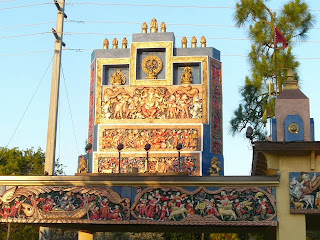The head of the sacrificial horse is the dawn, his eyes are the sun, his breath of life is the wind-god, his face is the fire-god, the centre of his body is the year, his back is heaven, his stomach is the atmosphere, his hooves are the earth, his sides are the four directions, his bones are the other directions, his limbs are the seasons, the joints of his body are the months and the fornights, his feet are the night and the day, his marrow is the stars, his flesh is the clouds, the undigested food in his stomach is sand, his veins are the rivers, his liver is the mountains, the hair of his body is the herbs and the trees, the front of his body is the rising sun, the rear of his body is the setting sun, his belching is the lightning, the shaking of his body is the thunder, and his neighing is speech.
(A sacrificial horse was used at horse-sacrifices and, in this verse, an analogy is being drawn between the Brahman and the sacrificial horse.)
The day is the vessel that is to the front of the horse and the origin of the day is in the eastern ocean. The night is the vessel that is to the rear of the horse and the origin of the night is in the western ocean.( Two golden or silver vessels were placed to the front and the rear of a sacrificial horse as receptacles for offering.) As haya the horse bears gods, as vaji he bears gandharvas(a semi-divine species), as arva he bears demons, and as ashva he bears humans.(Haya, vaji, arva andashva are all synonyms for a horse.) The ocean is the stable and it is in the ocean that the horse originated.













